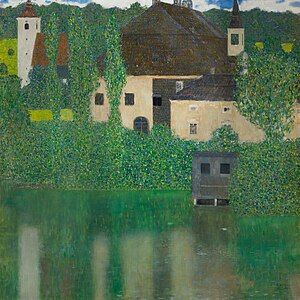Schloss by the Water
It is the first of four oil on canvas paintings in a series created in 1908-1910 during a summer holiday at the Villa Oleander at Schörfling am Attersee.[1] Klimt and the Flöge family rented the village from Scloss Kammer's owner, Countess Kefenhüller.[1] He chose a viewpoint from the quay by the villa,[1] from which the Schloss's cubic facade could be seen behind the lake's reflective surface through the tall pyramidal poplars.Using a self-invented cardboard 'viewfinder', a telescope and opera glasses, he also dissected the visible landscape into separate areas before rearranging them into separated planes of lake and shore - the church bell tower looks close to the Schloss but is in reality about 800 metres away by water in Seewalchen.The lack of shadows, the horizon line right at the top of the painting, the reflection and the limited palette of white, ochre and green[1] allowed him to flatten the image but still portray the landscape in a realistic-illusionistic fashion.
Gustav KlimtNational Gallery PragueSchörfling am AtterseeFlögeSeewalchenList of paintings by Gustav KlimtList of paintingsSchubert at the PianoBeethoven FriezeJudith and the Head of HolofernesInsel im AtterseeBirnbaumHope IThe Three Ages of WomanDanaëPortrait of Adele Bloch-Bauer IWater Serpents IIHope IIThe KissThe Tree of Life, Stoclet FriezePortrait of Adele Bloch-Bauer IIThe MaidenDeath and LifePortrait of a LadyWomen FriendsPortrait of Fräulein LieserPortrait of Johanna StaudeLady with a FanKlimt University of Vienna Ceiling PaintingsStoclet FriezeKlimt VillaErnst Klimt (brother)Emilie Louise Flöge (life companion)Bride of the WindStealing KlimtWoman in Gold